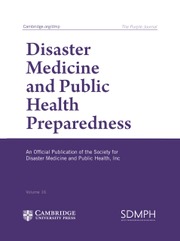Located in a region where disasters such as earthquakes, floods, forest fires, and weather events occur frequently, Türkiye is among the countries at high risk of earthquakes according to INFORM risk index data. 1 On February 6, 2023, 2 earthquakes of magnitudes 7.5 and 7.8 occurred in southeastern Türkiye and some parts of Syria. This earthquake, one of the deadliest disasters in the world, affected 14 million people in Türkiye. This letter examines the impact of this earthquake on children in Türkiye.
Most individuals who lose their lives in disasters are children. Children are a sensitive group that is different from adults in terms of their physiological characteristics, underdeveloped self-defense skills, and dependence on adults to meet their needs.Reference Ceylan 2 In fact, when Türkiye´s 2023 death statistics are examined, a significant increase is seen in infant and child mortality rates in the provinces affected by the earthquake. In Kahramanmaraş, the infant mortality rate increased from 9.0 per 1000 in 2022 to 20.8 per 1000 in 2023. In Adıyaman, the under-5 mortality rate increased from 11.8 per 1000 in 2022 to 82.8 per 1000 in 2023. 3 These data reveal the devastating effects of the earthquake.
In addition, children face many psychological, emotional, and social problems due to disasters. The loss, injury, or death of family members and friends due to disasters, the child’s injuries, and hospital procedures cause stress.Reference Kurt, Topan and Akkoç 4 Not only is the disaster itself stressful and frightening, but the damage and destruction in the living space after the disaster is also stressful. Children experience the same feelings when they see their parents experiencing fear and stress.Reference Kousky 5 Furthermore, children are indirectly affected by disasters. Social media and communication channels negatively affect children who do not experience disasters.Reference Kurt, Topan and Akkoç 6 Unfortunately, children can have difficulty coping with all these emotions. Studies have reported that after the 2023 earthquake in Türkiye, children and adolescents experienced fear and anxiety,Reference Efendi, Temeltürk, Çakmak and Dinçer 7 post-traumatic stress disorder,Reference Can Gür 8 , Reference Yakşi and Eroğlu 9 depression and anxiety disorder,Reference Yakşi and Eroğlu 9 emotional stress and behavioral problems,Reference Kurt, Topan and Akkoç 4 sleep problems,Reference Ceylan 10 , Reference Düken 11 and post-earthquake dizziness syndrome.Reference Çelebi and Akdağ 12
In the event of a disaster, the issues that need to be focused on with children are performing first aid appropriate to the child’s age; providing treatment and care; ensuring adequate hydration and nutrition; creating a suitable shelter and sleep environment; maintaining body temperature; preventing infectious diseases; security and protection; evaluating, protecting and improving mental health; education; and a family-centered approach. Therefore, to prevent children from being directly or indirectly affected by disasters, and to reduce and treat the effects of disasters, child-centered disaster plans should be prepared to meet the needs of children before the disaster, during the disaster response period, and during the post-disaster recovery period.Reference Ceylan 2 Thus, disasters’ permanent or temporary physical and psychological effects on children can be reduced.
Funding statement
Author did not receive any special funding from public or private institutions to perform this study.
Competing interests
No conflict of interest has been declared by the author.

